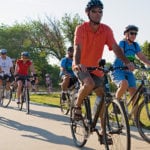Behind the Lens: New photograph not altered

This is a screen shot from my computer showing the raw image of a recent news photograph as it came from my camera with several other shots from the interview.
Every once in a while, a photographer will shoot an image that raises more questions than it answers. Sometimes it’s the photographer’s fault for not paying closer attention to exactly what he or she is communicating, and other times it’s simply the situation being photographed and the circumstances that surround it.
It’s not often that I reply to comments regarding my photos on LJWorld.com or KUSports.com. Feedback is really important to me, and hearing both encouraging and critical responses to my work is always helpful and appreciated. It’s what makes us better. I guess I feel as though if I’m not willing to publicly accept disparaging remarks, then I shouldn’t be so quick to publicly take the compliments either. About the only thing that gets me off the deck and into the pool of reader comments with everyone else is if I can add more information to help in the understanding of the photo or the story it accompanies.
On the morning of June 18, staffer Jonathan Kealing alerted me via e-mail to a lively discussion on LJWorld.com regarding the photo I made of Nathaniel Mehl and Aiden Waugh, the two teens who days before stopped an assault on the trails near Youth Sports Complex soccer fields. Readers were questioning whether the photo had been digitally manipulated or “Photoshopped.”
Whenever a photojournalist hears that word or term associated with one of his images, it quickly becomes a matter of public trust. More properly, to digitally alter a photograph with the intent to deceive or mislead is the granddaddy of all no-nos, so needless to say I was in the pool, headfirst, jeans, shoes and all, and even with my cell phone still in my pocket.
To add a little back story, the day after the attack, we at the News Center learned the identities of the two “good Samaritans,” as they were being warmly referred to around the office. Reporter Janet Reid contacted the two who were heading out for another run on the same trail. We arranged to meet them along the trail for the interview. When they showed up, they were shirtless, but I’ll get to that later.
The “Photoshopped” look is an understandable question and a pretty easy explanation. This is what I told readers with concerns. When we interviewed Mehl and Waugh, we did it primarily under the shade created by trees along the trail to keep them from squinting in the sunlight while they gave their account of what happened. I used a small softbox with a strobe positioned at high camera right to add some fill flash to the two young men. Everything else in the frame, including the trees and grass, are being lit by sunlight, which is coming in at a much different angle. Because we’re used to seeing images that are lit primarily by one light source, whether it be the sun or a single flash, sometimes the results of mixing two competing lights can be a bit jarring.
Now, the other part that readers took issue with was the fact that the two were shirtless when I photographed them. I didn’t reply to comments initially, because it seemed like more of a matter of personal taste rather than right or wrong. Certainly, it’s not wrong for a couple of guys to go running shirtless, and I’d say it’s pretty common to see such a thing on Lawrence’s popular running trails or anywhere else, for that matter.
Given the seriousness of the situation and the context of their involvement, I knew that being without shirts might raise a few brows to anyone who didn’t understand that they had ran several miles before we interviewed them. I might also add that I don’t believe the cause for the confusion to be on the part of Mehl or Waugh, because as much as I could tell, they were just trying to go about business as usual and were nice enough to talk with us.
Simply being at an interview is influencing enough on a journalist’s part, but documenting a news situation requires that we record the events and keep this influence to an absolute minimum. So with regard to this, even if they came with shirts in hand, I wouldn’t have asked them to put them on during the photos or interview.







